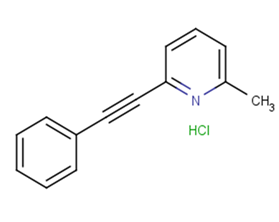
MPEP hydrochloride
CAS No. 219911-35-0
MPEP hydrochloride( —— )
Catalog No. M18248 CAS No. 219911-35-0
MPEP hydrochloride is an effective and highly specific non-competitive antagonist at the mGlu5 receptor subtype (IC50: 36 nM).
Purity : >98% (HPLC)
 COA
COA
 Datasheet
Datasheet
 HNMR
HNMR
 HPLC
HPLC
 MSDS
MSDS
 Handing Instructions
Handing Instructions
| Size | Price / USD | Stock | Quantity |
| 5MG | 35 | In Stock |


|
| 10MG | 56 | In Stock |


|
| 25MG | 113 | In Stock |


|
| 50MG | 204 | In Stock |


|
| 100MG | 266 | In Stock |


|
| 200MG | 345 | In Stock |


|
| 500MG | Get Quote | In Stock |


|
| 1G | Get Quote | In Stock |


|
Biological Information
-
Product NameMPEP hydrochloride
-
NoteResearch use only, not for human use.
-
Brief DescriptionMPEP hydrochloride is an effective and highly specific non-competitive antagonist at the mGlu5 receptor subtype (IC50: 36 nM).
-
DescriptionMPEP hydrochloride is an effective and highly specific non-competitive antagonist at the mGlu5 receptor subtype (IC50: 36 nM).
-
In VitroMPEP does not show agonist or antagonist activity at 100 mM on human mGlu2, -3, -4a, -7b, and -8a receptors nor at 10 μM on the human mGlu6 receptor.
-
In VivoMPEP (1-30 mg/kg) induces anxiolytic-like effects in the conflict drinking test and the elevated plus-maze test in rats as well as in the four-plate test in mice.MPEP (1-20 mg/kg) does shorten the immobility time in a tail suspension test in mice, however it is inactive in the behavioural despair test in rats.MPEP (30 mg/kg i.p.) slightly but significantly increases (by 39%) the number of punished crossings in the four-plate test, lower doses of the compound (3 and 10 mg/kg) does not affect the number of punished crossings in that test (F (3,36)=3.240, P<0.05). MPEP (1, 10 and 20 mg/kg) significantly (by 55% after the highest dose), (F(3,28)=15.47, P<0.001) decreases the immobility time of mice in the tail suspension test. Its efficacy is similar to that of imipramine (20 mg/kg), used as the positive standard. Animal Model:Male Wistar rats (200 ± 250 g).Dosage:IP or PO.Administration:0.3, 1 and 10 mg/kg, i.p. (Conflict drinking test).Result:At a dose of 0.3 mg/kg was not ffective, at doses of 1 and 10 mg/kg i.p. significantly (F (3,30)=11.193, P<0.001), increased the number of shocks (by 330 and 507%, respectively) accepted during the experimental session in the Vogel test. Animal Model:Male Wistar rats (200 ± 250 g).Dosage:IP or PO.Administration:1, 3 and 10 mg/kg, i.p. or 10 and 30 mg/kg, p.o.(Elevated plus-maze test).Result:Administered at a dose of 1 mg kg71 i.p. did not change the entries into and time spent in the open arms. At doses of 3 and 10 mg/kg i.p. significantly (F (3,24)=22.978, P<0.001) dose-dependently increased the time spent in the open arms (up to 45 and 74%, respectively), and the percentage of entries into the open arms (up to 48 and 68%, respectively, F(3,24)=5.678, P<.01). At doses of 3 and 10 mg/kg i.p. significantly increased (by 64%) the total number of entries and reduced (by about 25%) the total time.spent (data not shown) in the arms (either type). At the dose of 30 mg/kg (po, but not 10 mg/kg) significantly (up to 64%, F (2,16)=14.249, P<0.001) increased the percentage of the time spent in the open arms and the percentage of entries into the open arms (up to 63%, F (2,16)=7.295, P<0.01). MPEP given p.o. in both doses used did not change the total number of entries nor the total time spent in the arms (either type).
-
Synonyms——
-
PathwayOthers
-
TargetOther Targets
-
RecptormGluR
-
Research AreaNeurological Disease
-
Indication——
Chemical Information
-
CAS Number219911-35-0
-
Formula Weight229.7
-
Molecular FormulaC14H12ClN
-
Purity>98% (HPLC)
-
SolubilityH2O : ≥ 50 mg/mL; 217.68 mM
-
SMILESc1(ccccc1)C#Cc1cccc(n1)C.Cl
-
Chemical Name——
Shipping & Storage Information
-
Storage(-20℃)
-
ShippingWith Ice Pack
-
Stability≥ 2 years
Reference
1. Inta Dragos, et al. Neuropharmacology (2012), 62(5-6), 2034-2039.
molnova catalog



related products
-
PAR-2 (6-1) amide (h...
PAR-2 (6-1) amide (human)
-
(+)-Dipentene
Limonene has good antitussive expectorant and bacteriostatic effects.
-
Fasoracetam
Fasoracetam is a modulator of GABA receptor potentially for the treatment of attention deficit hyperactivity disorder.



 Cart
Cart
 sales@molnova.com
sales@molnova.com


